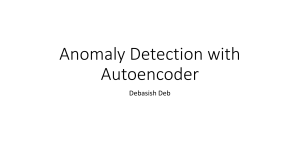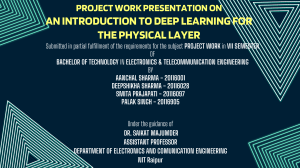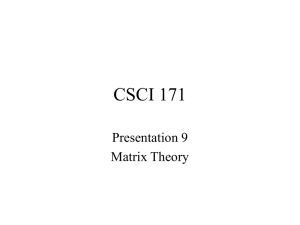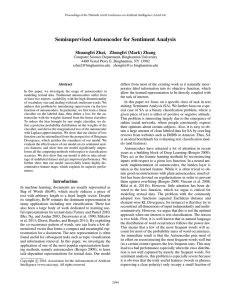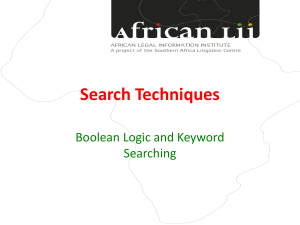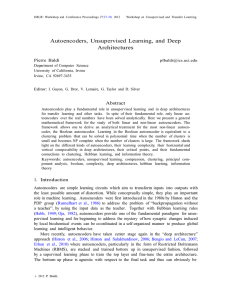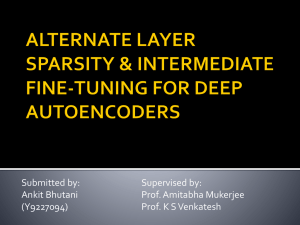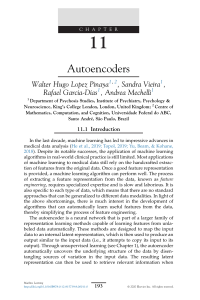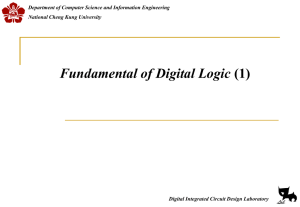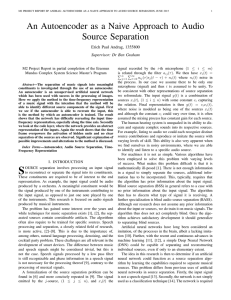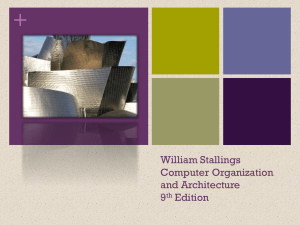slides - Clopinet
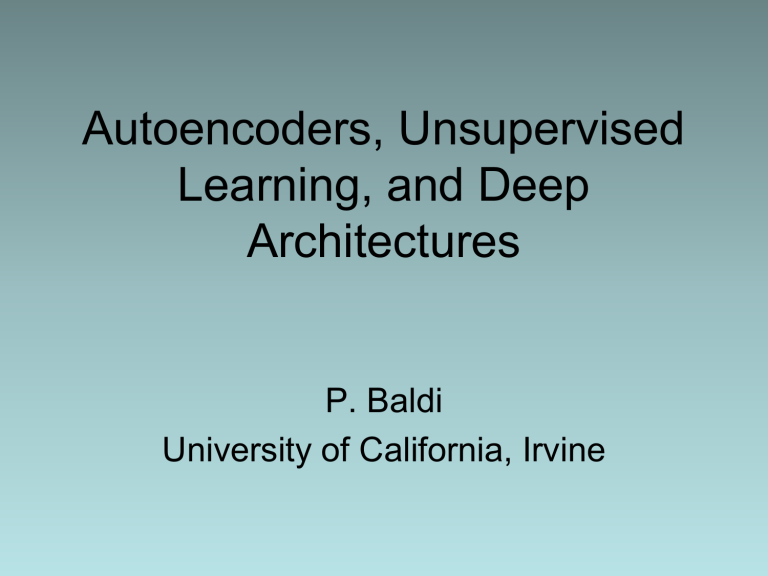
Autoencoders, Unsupervised
Learning, and Deep
Architectures
P. Baldi
University of California, Irvine
1. General Definition
2. Historical Motivation (50s,80s,2010s)
3. Linear Autoencoders over Infinite Fields
4. Non-Linear Autoencoders: the Boolean
Case
5. Summary and Speculations
General Definition
• x
1
, ,x
M training vectors in E N (e.g. E=IR or {0,1})
• Learn A and B to minimize :
i
Δ[
F
AB
(x i
)-x i
]
N
A
H
B
N
Key scaling parameters: N, H, M
Autoencoder Zoo
Autoencoders
Linear Non-Linear
Complex Real Finite Fields (GF2) Boolean Boolean/Linear
Neural Network
(sigmoidal)
Boltzmann
Machines
Threshold Gates RBMs
Historical Motivation
• Three time periods: 1950s, 1980s, 2010s.
• Three motivations:
– Fundamental Learning Problem (1950s)
– Unsupervised Learning (1980s)
– Deep Architectures (2010s)
2010: Deep Architectures
1950s
Where do you store your telephone number?
THE SYNAPTIC BASIS OF MEMORY CONSOLIDATION
© 2004, Graham Johnson
© 2007, Paul De Koninck
Size in Meters
Diameter of Atom 10 -10
Diameter of DNA 10 -9
Diameter of
Synapse
10 -7
Diameter of Axon 10 -6
10 -5 Diameter of
Neuron
Length of Axon
Length of Brain
10 -3
10 -1
-10 0
Length of Body 1
Scales x10 6
10 -4
10 -3
10 -1
1
10
10 3 -10 6
10 5
10 6
Hair
Fist
Room
Park-Nation
State
Nation
The Organization of
Behavior: A
Neuropsychological
Theory (1949)
Let us assume that the persistence or repetition of a reverberatory activity (or “trace”) tends to induce lasting cellular changes that add to its stability…….
When an axon of cell A is near enough to excite a cell B and repeatedly or persistently takes part in firing it, some growth process of metabolic change takes place in one or both cells such that A’s efficiency, as one of the cells firing B, is increased.
Δw ij
~ x i x j
• Hopfield
• PDP group
1980s
Back-Propagation (1985)
BACK-PROPAGATION
ERROR E=F(w)
OUTPUT LAYER i
W ij j
INPUT LAYER
GRADIENT DESCENT: Δ w ij
= µ out j є i
µ = learning rate
First Autoencoder
• x
1
, ,x
M training points (real-valued vectors)
• Learn A and B to minimize
i
||F
AB
(x i
)-x i
|| 2
N sigmoidal neurons
A
H sigmoidal neurons
B
N
Linear Autoencoder
• x
1
,…,x
M training vectors over IR N
• Find two matrices A and B that minimize:
i
|| AB(x i
)-x i
|| 2
N
A
H
B
N
Linear Autoencoder Theorem (IR)
• A and B are defined only up to group multiplication by an invertible
HxH matrix C: W = AB = (AC -1) CB.
• Although the cost function is quadratic and the transformation W=AB is linear, the problem is NOT convex .
• The problem becomes convex if A or B is fixed . Assuming Σ
XX is invertible and the covariance matrix has full rank : B*=(A t A) -1 A t and
A*= Σ
XX
B t (B Σ
XX
Bt) -1 .
• Alternate minimization of A and B is an EM algorithm.
A
B
Linear Autoencoder Theorem (IR)
• The overall landscape of E has no local minima . All the critical points where the gradient is 0 are associated with projections onto subspaces associated with H eigenvectors of the covariance matrix.
At any critical point: A=U
I
C and B=C are the H eigenvectors of Σ
XX
-1 U
I where the columns of U
I associated with the index set I. In this case, W = AB = P
UI correspond to a projection. Generalization is easy to measure and understand.
• Projections onto the top H eigenvectors correspond to a global minimum. All other critical points are saddle points.
N
A
H
B
N
Landscape of E
A
B
Linear Autoencoder Theorem (IR)
• Thus any critical point performs a form of clustering by hyperplane.
For any vector x, all the vectors of the form x+KerB are mapped onto the same vector y=AB(x)=AB(x+ KerB).
• At any critical point where C=Identity A=B t . The constraint A=B t can be imposed during learning by weight sharing, or symmetric connections, and is consistent with a Hebbian rule that is symmetric between pre-and post- synaptic units (folded autoencoder, or clamping input and output units).
N
A
H
B
N
Linear Autoencoder Theorem (IR)
• At any critical point, reverberation is stable for every x
(AB) 2 x=ABx
• The global minimum remains the same if additional matrices or rank
>=H are introduced anywhere in the architecture. There is no gain in expressivity by adding such matrices.
• However such matrices could be introduced for other reasons.
Vertical Composition law: “NH1HH1N ~NH1N + H1HH1”
• Results can be extended to linear case with given output targets and to the complex field.
N
A
H
B
N
Vertical Composition
• NH1HH1N ~ NH1N + H1HH1
H1
N
H1
H
N
H1
H
H1
N
H1
N
H
H1
N
Linear Autoencoder Theorem (IR)
• At any critical point, reverberation is stable (AB) 2 x=ABx
• The global minimum remains the same if additional matrices or rank
>=H are introduced anywhere in the architecture. There is no gain in expressivity by adding such matrices.
• However such matrices could be introduced for other reasons.
VerticalcComposition law: “NH1HH1N ~NH1N + H1HH1”
• Results can be extended to linear case with given output targets and to the complex field.
• Provides some intuition
N for the non-linear case.
A
H
B
N
Boolean Autoencoder
Boolean Autoencoder
• x
1
,…,x
M training vectors over IH N (binary)
• Find Boolean functions A and B that minimize:
i
H[ AB(x i
),x i
]
H= Hamming Distance
• Variation 1: Enforce AB(x i
)
{x
1
,…,x
M
}
• Variation 2: Restrict A and B (connectivity, threshold gates, etc)
Boolean Autoencoder
Fix A
Boolean Autoencoder
Fix A h=10010
Boolean Autoencoder y=A(h)=11010110010 h=10010
Fix A
Boolean Autoencoder
A(h2)
A(h1) y=A(h)=11010110010 A(h3)
Fix A h=10010
y=A(h)=11010110010 h=10010
Autoencoder
A(h1)
A(h2)
A(h3)
Fix A
B({Voronoi A(h)}) =h
y=A(h)=11010110010 h=10010
Autoencoder
A(h1)
A(h2)
A(h3)
Fix A
B({Voronoi A(h)}) =h
Boolean Autoencoder
Fix B
Boolean Autoencoder h=10100
A
Fix B
Boolean Autoencoder
A(h)=?
h=10100
A
Fix B
Boolean Autoencoder
A(h)=?
h=10100
00110101001
11010100101
10101010101
A
Fix B
Boolean Autoencoder
A(h)=10110100101 h=10100
00110101001
11010100101
10101010101
A
Fix B
Boolean Autoencoder
A(h)=10110100101 h=10100
00110101001
11010100101
10101010101
A
A(h)=Majority[B -1 (h)]
Fix B
Boolean Autoencoder Theorem
• A and B are defined only up to the group of permutations of the
2H points in the H-dimensional hypercube of the hidden layer.
• The overal optimization problem is non trivial. Polynomial time solutions exist when H is held constant (centroids in the training set).
When H~ εLogN the problem becomes NP-complete .
• The problem has a simple solution when A is fixed or B is fixed:
A*(h)=Majority {B -1 (h)} B*{Voronoi A(h)}=h [B*(x)=h such that A(h) is closest to x among {A(h)}].
• Every “critical point” (A* and B*) correspond to a clustering into
K=2 H clusters. The optimum correspond to the best clustering.
(Maximum?) Plenty of approximate algorithms (k means, hierarchical clustering, belief propagation (centroids in training set).
• G eneralization is easy to measure and understand.
Boolean Autoencoder Theorem
• At any critical point, reverberation is stable.
• The global minimum remains the same if additional Boolean functions with layers >=H are introduced anywhere in the architecture. There is no gain in expressivity by adding such functions.
• However such functions could be introduced for other reasons.
Composition law: “NH1HH1N ~NH1N + H1HH1”. Can achieve hierarchical clustering in input space.
• Results can be extended to the case with given output targets.
Learning Complexity
• Linear autoencoder over infinite fields can be solved analytically
• Boolean autoencoder is NP complete as soon as the number of clusters (K=2 H ) scales like M
ε
(for ε>0). It is solvable in polynomial time when K is fixed.
• Linear autoencoder over finite fields is NP complete in the general case.
• RBM learning is NP complete in the general case.
Embedding of Square Lattice in
Hypercube
• 4x3 square lattice with embedding in H 7
0000111 1111111
0000000 1111000
Vertical Composition
Horizontal Composition
Autoencoders with H>N
• Identity provides trivial solution
• Regularization//Horizontal Composition//Noise
Information and Coding
(Transmission and Storage) decoded message noisy channel parity bits message
Summary and Speculations
Autoencoders
Linear Non-Linear
Complex Real Finite Fields (GF(2)) Boolean
Boolean/Linear over R or C
Neural Network
(sigmoidal)
Boltzmann
Machines
Boolean/Linear over GF(2)
Threshold Gates RBMs
Unsupervised Learning
Clustering
Autoencoders
Hebbian
Learning
Information and Coding Theory
Compression
Autoencoders
Communication
Autoencoders
Deep Architectures
Vertical
Composition
Horizontal
Composition
Summary and Speculations
• Unsupervised Learning: Hebb,
Autoencoders, RBMs, Clustering
• Conceptually clustering is the fundamental operation
• Clustering can be combined with targets
• Clustering is composable: horizontally, vertically, recursively, etc.
• Autoencoders implement clustering and labeling simultaneously
• Deep architecture conjecture
